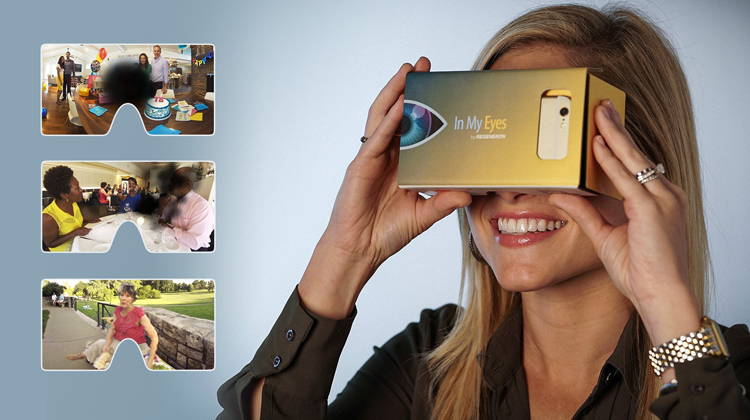How Regeneron Aims to Stay on Message With VR/AR APP

Virtual reality has been used to train surgeons, to evaluate balance control and associated fall risk in glaucoma patients, and, more recently, to create simulations that allow users to better understand the visual effects of various eye diseases.
To the latter, Regeneron and Intouch Solutions have developed and released the In My Eyes smartphone app. Using both virtual reality (VR) and augmented reality (AR), the app provides a visual representation of how the world looks to people with three different retinal diseases: wet age-related macular degeneration (AMD), diabetic macular edema, and macular edema following retinal vein occlusion.
Search for an Empathetic Tool
Natalie Mancuso, Regeneron’s senior manager, patient consumer marketing, ophthalmology, says the app was inspired by five years of conversations with patients, caregivers, and healthcare professionals about the challenge of how to recognize and articulate the patient experience. “For us it was really about trying to develop a tool that could help facilitate more of these proactive and productive conversations between family members as well as with their healthcare professionals,” she adds.
Brent Scholz is VP, executive creative director at Intouch Solutions, which handles Regeneron’s digital marketing needs. He explains his team realized what was needed to deliver the message effectively was empathy for the situation of the patients, and that’s something virtual reality can deliver. “You’re basically allowing people who aren’t familiar with something to try to become familiar with it, and see it for themselves,” he says.
The app was originally designed for Regeneron’s sales team to share with physicians and other healthcare professionals, but, Mancuso notes, “We very quickly saw the value of extending this into the conversation amongst family members and also people who care for patients or loved ones with disease. ”
How the APP Works
Regeneron’s Eylea (aflibercept) is indicated for all three of the diseases represented in the app. The app launches with an entry screen that shows prescribing and safety information. Once inside the app, some branding for Eylea appears as you answer a couple of questions to get started, but that branding disappears when the disease demonstration begins.
Regeneron unveiled the app at the American Academy of Ophthalmology annual meeting in October, and it has been available for download by the public on Google Play and iTunes since January. Once downloaded, the app is very simple to use. Beyond the initial entry screen are a couple of set-up questions, one of which asks if you have access to a Google Cardboard Headset, a simple VR headset. The app can work with or without the headset. With the headset, the demonstration appears as stereoscopic images on your phone; without, it appears as a single image.
For each of the diseases, the user chooses either story mode (VR) or live mode (AR). Story mode has three short videos, in which the user is seeing from the perspective of the patient, with the symptoms of the selected disease imparted on a particular experience in that patient’s life.
In live mode, the app accesses the phone’s camera, and the symptoms of the disease show against whatever the camera is seeing. Mancuso says the live mode “really brings it to relevance in terms of if you’re trying to read something on your computer, or trying to look at your front door to put your key in the lock. It allows you to have a real-time, in-the-moment experience.”
Scholz points out that live mode also “extends the lifespan” of the usefulness of the app. If the app only contained the story mode, once the three videos have been viewed, there would be no reason to continue using the app. But with live mode, the view is always different and relevant to the user’s own experience.
Next Up: APP Extensions
Going forward, Scholz says Intouch Solutions and Regeneron will explore how they can extend the app. One idea involves taking the 360-degree files used in story mode and placing them on people’s desktops, not just their phones. Scholz also says that the idea of using VR and AR is gaining traction within Intouch. “It’s exciting to see people who work on other brands, in totally different spaces, start to brainstorm,” he adds.
Both Mancuso and Scholz say that although VR can be tempting to use because it’s fun and flashy, it’s not always appropriate. “For us it’s about making sure that we’re truly delivering a resource that helps support our customers,” Mancuso stresses. “While the app is relatively new, we’re very pleased with what we’re hearing from both our field teams and some people who have used it in real-time experience; we really want to see people being able to better communicate. ”
Steve Lenier has worked with medical content for almost 30 years, with an emphasis on ophthalmology since 2005. – @SteveLenier

